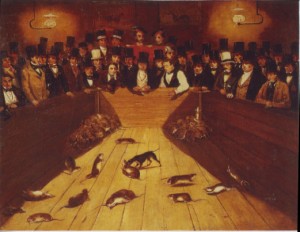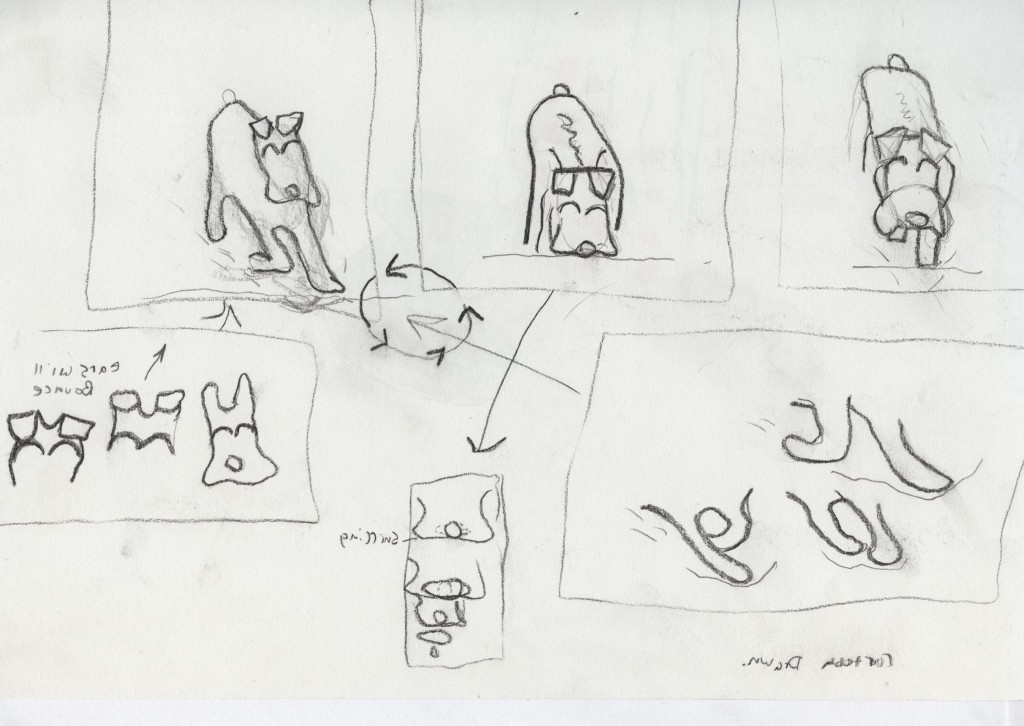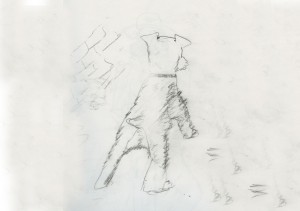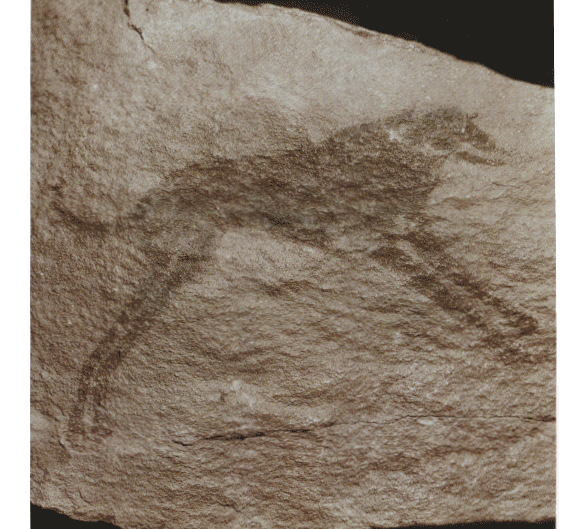Canis Lupus Familiarus
Kingdom: Animalia
Phylum: Chordata
Class: Mammalia
Order: Carnivora
Family: Canidae
Genus: Canis
Domestic animal Observed in Urban back yard. Global Pet.
Introduction:
My work this quarter was centered on Ranger; a black and
gray Miniature Schnauzer. I don’t consider myself a dog person and care even
less for the tiny kind. I had a prejudice to all “miniature” dogs as I saw them
as accessories for ascot wearing rich folk. Starting this project I thought
Ranger would be hard pressed to teach me something new or change my opinion about
dogs in general. Through my research,
animations, observations, and writing practices, I realized that there was much
more to the character of “Tinny Dog” than that of rattly looking yapper.
The
first thing I learned was through my observations where learned how damn cute Miniature
schnauzers are. Even as puppy’s they have “mustaches” making them looked like a
furry Martin Scorsese, Groucho Marx hybrids; a fact I carried over to my
character designs during the animation sequence. The most profound impact came
from my natural history research where I discovered that dogs have earned their
rightful place in our modern lives as we learned to live with them even before
we learned to live with each other in towns and cities.

Ranger
Miniature Schnauzer
Canis Lupus Familiaris
Kingdom: Animalia
Phylum: Chordata
Class: Mammalia
Order: Carnivora
Family: Canidae
Genus: Canis
Group: Terrier
Height: 12-14”
Colors: Black, Salt and Pepper, Black and Silver
Hair Type: Double coated, wiry, hard and coarse, topcoat, soft undercoat
Personality: Obedient, timid, playful, friendly, intelligent, alert.
Origination: Germany. Bred from Giant schnauzers Affenpinschers and Miniature Pinchers.Bred for hunting vermin.
Life expectancy: 14 years.
Natural History:
The origin of the domestic dog is debated. The Goyet Cave,
Belgium (Germonpré and colleagues, 2009) contained a fossilized canid skull
that has been direct-dated by AMS (Accelorator Mass Spectrometry) at 31,700 BP. The skull most closely represents prehistoric dogs, rather than wolves. Prehistoric dogs at Chauvet Cave (~26,000 bp)
and Mezhirich in the Ukraine (ca 15,000 years BP), among others. In 2012
(Germonpré and colleagues 2012) Gravettian Predmostí cave in the Czech Republic, which contained
two more between 24,000-27,000 BP.
(Wang)
- 400,000 years ago man and wolf share the same hunting ground and habitat, as indicated by evidence descovered at the site of Boxgrove, Kent, UK.
- 14,000 years ago earliest evidence of domestic dog (a mandible) bonn-Oberkassel, Germany.
- 12,000 years ago Northern Israel, puppy and human buried cradled together.
- 10,000 years ago Dog wolf hybrids in North America. Basin site Wyoming, USA.
- 8,000-3,000 years ago Magnificent limestone ‘Statue of a Dog’ is made in Mesopotamia.
- 3,000-4,000 years ago distinctly different types of dogs emerge, identifiable from artwork including the greyhound type, mastiff type and small, short–legged dog.
(Pickeral 276)
Observation Notes:
I spent 3 hours a week observing Ranger from the comfort of my Father inlaws recliner, watching Ranger through the sliding glass window, bound and dig and sniff their 500 sq. ft. backyard.
Excerpt taken from my animal book:
“Ranger seems to be learning his boundaries with other dogs…They seem to be strict verbally but gentle and patient with Ranger. They seem to understand he is a puppy… He is growing faster than I expected. I would guess he has gained 5 lbs in 3 weeks.”
Cultural History:

Norman Rockwell (1894-1978) Common Problems, or Waiting for the Vet. 1952. Oil on masonite 43.2x39.4 cm Private Collection
Hair of the dog that bit you. See a man about a dog. Work like a dog. Hot dog! Woof! Bitch! these are just a few common phrases that are universaly understood in American culture.Our language is rich with our relationship with dogs. Getting a dog seems to be a “right of passage” for kids to demonstrate how responsible they are. New couples often get a dog as the “Next step” in a relation ship. Dog in occupations: Certin breeds can be trained to assist the disabled, used as hunters, search and rescue and some like our schnauzer with a high enough sense of smell can even be used to detect lung cancer (ScienceDaily (Aug. 17, 2011).

English School Rat-Catching at the Blue Anchor Tavern. 1850-52. Oil on canvas London, Museum of London
Terriers used as betting tool 1800’s England. Patrons would bet on number of killed rats.
Marcus Antonius:
And Caesar’s spirit, raging for
revenge,
With Ate by his side come hot from hell,
Shall in these confines
with a monarch’s voice
Cry “Havoc!” and let slip the dogs of war,
That this foul deed shall smell above the earth
With carrion men, groaning for
burial.
College Essay:
Best Friend
Somewhere right now in the ice fields of Siberia, the sharp peaks of Peru or the coarse entombing sands of the Libeyan desert; a dusty academic is brushing off layers of time from the remains of a acient somebody; and not far from this imprint is the unmistakable presence of a four footed companion, loyal even in death. To Canis Lupus Familiaris, the title of “man’s best friend” was not loosely bestowed.
Though there is debate about their original purpose, whether protection, hunting aid or warring companion, they clearly had one.
The smell is not always in the same spot and sometimes it moves while he is sniffing it.
The other dogs in the yard, much bigger than Ranger, don’t seem to realize that something is down there. These dogs only seem interested in bringing a choice stick to the man doing the tossing. Ranger doesn’t care for such things. He only wants to know what it is he smells inches below the top soil of the rose garden, grass or beauty bark. Is there a need today for a sense of smell millions of times stronger than my own. If so theire would be an app for it. The need for a dogs is not as dire as it was in our ancient beginnings. None—the—less we seem reluctant to let them go. Dogs have successfully maintained a role in our ever-changing home life while other once domestic animals have been left behind. This is largely due to carefully selected breeding processes, meant to twist a dog’s personality and usefulness to fit into our changing civilization.
Ranger is a miniature schnauzer bred for hunting vermin; a fact I keep reminding myself when he tears up the yard and b rings me a chewed up mole. When he is looking up at me panting through a smile, a mole at my feet and a muddy red tong hanging lazily to one side of his woolly snout, somewhere in the deepest reaches of his DNA; the ancient imprints of those first prehistoric companions give each other a high-five in recognition of a the earned place under the roof of man.
Animation Sequence:
This animation project gave me a chance to illustrate character traits I observed in Ranger. For instance. he likes to “garden.” I wanted to put strong attention on the movement of the ears, mostly because they were adorable to watch bounce.Animation Story Board:

RANGERTOON
work cited
Derrr,
Mark. “Dog’s best friend: annals of the dog-human relationship.” New York: University of Chicago Press, 2004. Print.
Rugh,
Karla. “Miniature Schnauzers.” Hauppauge, NY: Barron’s. 1997. Print.
Bain,
Terry. “You are a Dog: life through the eyes of man’s best friend.” New York:
Harmony Books, 2004. Print.
Schaffer,
Michael. “One nation under Dog.” New York: Holt, 2009. Print.
Schwartz,
Marion, “A history of dogs in the Early Americas.” The New York Times on the
Web. Yale UP, 21April 2012. 1997. Print.
Olsen
Stanley. “ Origins of the Domestic Dog.”
Hafez,
E.S.G. “The Behavior of Domestic Animals,”
Pickeal,
Tamsin. “The Dog: 5000 years of the dog in art.”
Catharine,
Johns. “Dogs: History, Myth, Art.”
Cambridge Mass: Harvard UP. 2008.
Print.
Rubin,
James Henry. “Impressionists cat & dogs: pets in paintings of modern life.”
New Haven: Yale UP, 2003. Print.
Hafez,
ESE. “Adoption of Domestic Animals.”
1922. Philadelphia, Lea& Febige, 1968. Print.
Clutton
Brock, Jullet “Domesticated Animals from early times.” Austin: U.Texas P ;
London. 1981. Print.
Wang,
Xiaoming, Tichard H. Tedford. “How Dogs Came to Run the World.” Natural History Mag. Colombia UP. 2008.Web.
Ludington,
Mary. Patricia Hamp. “The nature of Dogs.” Newyork, Ny. S & S. 2007. Print.
VISUAL
Tetro,
Marc. Schnauzer on Red.2008.
LeBeastroonline
Fitzgerald,
Jean. Miniature Schnauzer. Jeansdogshop. May 2012.
Web.
Miniature Schnauzerh. Dogsindepth: the online dog http://www.dogsindepth.com/terrier_dog_breeds/miniature_schnauzer.html
2012.web.
Germonpré M, Láznicková-Galetová M, and
Sablin MV. 2012. Palaeolithic dog skulls at the Gravettian Predmostí site, the
Czech Republic. Journal of Archaeological Science 39(1):184-202.
Germonpré M, Sablin MV, Stevens RE,
Hedges REM, Hofreiter M, Stiller M, and Despré VR. 2009. Fossil dogs and wolves
from Palaeolithic sites in Belgium, the Ukraine and Russia: osteometry, ancient
DNA and stable isotopes. Journal of Archaeological Science 36(2):473-490.
Ovodov ND, Crockford SJ, Kuzmin YV,
Higham TFG, Hodgins GWL, and van der Plicht J. 2011. A 33,000-Year-Old
Incipient Dog from the Altai Mountains of Siberia: Evidence of the Earliest
Domestication Disrupted by the Last Glacial Maximum. PLoS ONE 6(7):e22821. Open
Access
Pionnier-Capitan M, Bemilli C, Bodu P,
Célérier G, Ferrié J-G, Fosse P, Garcià M, and Vigne J-D. 2011. New evidence
for Upper Palaeolithic small domestic dogs in South-Western Europe. Journal of
Archaeological Science 38(9):2123-2140.
Rainer Ehmann, Enole Boedeker, Uwe Friedrich, Jutta Sagert, Jürgen Dippon, Godehard Friedel, Thorsten Walles. Canine scent detection in the diagnosis of lung cancer: Revisiting a puzzling phenomenon. European Respiratory Journal, 2011; DOI:










